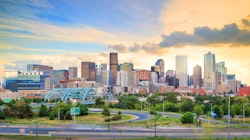

M|O Perspectives
Check back here for our thoughts on the latest developments in our industry.
Adaptability prevails. In design. In investments. In life.
May 29, 2018
“It is not the strongest of the species that survives, nor the most intelligent that survives. It is the one that is most adaptable to change.” –Charles Darwin
_
(As appears in NAREIM Dialogues Spring issue, 2018)_
A fallacy of many of today's intelligent sustainable buildings is the inability of so-called intelligent buildings’ abilities to adapt to changing societal trends and technologies. A school of thinking is emerging which posits that the best building designs for the long term are ones which allow for adaptation over time.
Adaptability is the feature which allows a thing to change to fit a new use or requirement. An expectation of change and the need for an adaptation to that change should be the foundation of any design concept for a building which is planned to have a long lifespan—and be a profitable and wise investment. Buildings tend to be thought of as anchored in place and time. While buildings generally do not move, it is clear that if they are to exist well into the future, they must be thoughtful about times, trends and the changing demands of the occupants.
Though buildings of the past had perhaps a somewhat easy task in responding to the technological changes over time, the pace of change in the last few decades has really challenged our notion of adaption. It would be overconfident to think we can predict changes. But it holds true that buildings with "good bones" can continue to change and adapt, while those without will become the UN-sustainable content of landfills.
Adaptive design is sustainable design
Sustainability is a topic that arises in real estate conversations frequently these days. No matter where you stand on the politics of climate change, the idea of using MORE energy and resources when better options are available is clearly outdated thinking. No matter how sustainable a project is, the construction of a structure takes a tremendous amount of resources, both physical and financial.
The most sustainable new building is the one that does not have to be built. Buildings that are poorly designed with respect to adaptability and basic design principles are more likely to be replaced before they have reached the end of their expected useful life than structures which allow for change and evolution. Great examples are some of the buildings and homes in the 1970s-80s when tech really started to propel changes—it played out in limited-thinking at a time perhaps when things felt so new and grandiose, people really couldn’t imagine what could come next. Nor did they even think about how to build for that. It was all about what we can show off today as the latest and greatest feature. That collective arrogance has become a hindrance to reinventing these assets.
Crystal ball, anyone?
Looking back over the last 20-30 years seems like a view into a whole new era when it comes to technology and the pace of change. The buildings designed in the 1940s or 1950s were, for the most part, considered acceptable to users in the 1990s. The styles may have evolved, but the technology driving buildings had largely been intact for decades. And no one then could anticipate the impending rapid aging of investments that was just around the corner. The internet and its widespread access to a range of technology platforms has truly changed everything.
It is obviously easier for a building to change interior paint colors and finishes as they become aesthetically dated then it is for a building to change core technology. But predicting what that new technology will be is not as easy as it was in the past. Think about space dedicated in buildings of the past to telephone booths or drinking fountains, both of which are disappearing from modern designs—not to mention the very-specific built-ins for TVs and audio systems that quickly become irrelevant. What elements of today's designs will be unnecessary or sabotage the future use of a structure?
We don't know what the technologies of the future will bring to us. Will senior housing change as we are better able to monitor and assist our aging family members through cameras and sensors that alert us to changes in vital signs? Site planning on all kinds of projects will be changed by technology. How will we move around our cities? Will we use autonomous vehicles? Will those vehicles be electric powered? How will the ever-increasing list of devices we all carry change the plug loads and associated electrical systems in our buildings? Conversely, will there maybe even be a backlash from technology overload and the focus becomes all about spaces where people connect—to other people?
Building community legacies
Recently, here at Marx|Okubo, we encountered a project experience that highlights the importance of thinking ahead in a way that really stretches the imagination. A client that is a religious organization (which many might consider as low-tech in nature) challenged us to help them build a structure which would not only be standing—but viable and sustainable—when it is 300 years old. Quickly the discussion moved from the things that won't be different in 2318, such as the orientation of the sun and awareness of expected seismic activity to the things that were almost imponderable, like what technologies will be available to monitor and manage the structure's day-to-day operations and what will energy cost. In the end, the most incontrovertible fact is that adaptability and the ease of integration for new systems was key to any model of success. Our advice has been to consider the long term with respect to the durability of material selections, open system architecture and flexibility of energy delivery methods.
Los Angeles hotel: New era, new electrical
Another example we encountered was a recent project where adaptability planning would have been desirable is with a hotel project under construction that we are currently monitoring in the Los Angeles area. This hip, urban hotel was able to increase room count successfully after the start of construction through an amended agreement with the city. Although this improved the future facilities revenues, the project developers ran into trouble with the portion of the amended agreement that called for a higher electric vehicle parking stall count. The added electrical panels and other features to accommodate the higher loads became problematic because of a lack of space in electrical rooms and difficulty and associated cost of running conduit to the future stall locations. Cutting things too close in initial design can leave little room for future space planning adjustments that can improve a property. While not always possible, our teams are tireless advocates for leaving a bit of room for future expansion in mechanical and electrical support spaces.
Shortsightedness will crush an asset
As owners, investors, developers and designers of buildings, we can’t predict but need to proactively encourage our projects to evolve with changes that are coming, as opposed to settling for something that works today and maybe only a couple of years into the future. With mechanical, electrical, plumbing and fire/life safety systems sometimes making up 40 to 50 percent of a building’s value, it is simply too expensive to make poor choices or to lock an owner/investor into a vendor or method that may not match well with future needs. For example, smart designs are planning for future wired and wireless connectivity through the deployment of distributed antennae systems, non-proprietary building management systems and open architecture designs for fire/life safety systems and other key building components. Another decidedly low-tech building feature allowing adaptability is the refinement of finishes and the addition of ample blocking or strapping in stud walls to allow for the adjustment of grab bars, rails, shelfs and other interior components, which assist in mobility for the disabled. Whether the feature is high- or low-tech, building elements that allow for change in the user population, as well as in technology, are ultimately stronger solutions in the long run.
Good design is ageless
While we must accept that some elements of buildings need to change over time, other things are universally desirable regardless the location of the facility. No matter what the structure type or use, basic universal design elements such as maximizing natural light, capturing views, creating robust and resilient structural systems, and integrating logical circulation patterns have always been, and will be, design elements which appeal to building owners, investors and users. Basing a design on these universally-favored features and working _with _the surroundings/environment, while at the same time allowing the technological features to change and be adapted, allows the building to be viable well into the future.
Think about the buildings that are being reused today across the country as creative office space structures. The vast majority include durable interior elements, an abundance of light, high ceiling heights and flexible use of space for bigger gatherings or individual needs. The elements that make these buildings attractive are very universal design qualities and meet the intrinsic needs we have for light, connectedness and focus.
While the idea of our octogenarian relatives being challenged by computer technology is common today that may not be the case in 20 or 30 years, as younger people who have grown up with computers age and move into housing designed specifically for the elderly. How would we feel if we walked into a residential development design for the elderly and saw multiple large format monitors on each unit’s wall and found wireless connectivity throughout the structure? Would we be surprised by wireless cameras and door bells at each entry and would we find it out of place to have a sophisticated environmental control panel controlling the lighting, temperature and white noise on the wall in each unit? That scenario may seem farfetched but is completely realistic given today’s population and technology trends. How well would the senior housing of today fare tomorrow with all those additional technological demands?
A recipe for long-term success
As societies and user groups change, so should the buildings that are designed for them. As any aging baby boomer will tell you, the wise tenets of life parallel those of good structures: Flexibility coupled with good bones will make for an easier life and easier transitions as the years roll by. Buildings and their embodied technology are changing at a mind-boggling pace. The only thing that seems certain is that technological change is always coming quickly, if it is not ringing your wireless internet-connected doorbell right now. Combining the ability to change and adapt building systems with solid and timeless design precepts will help ensure that a building or complex is still being used and not part of a landfill down the road. And with ever-increasing costs and ever-tightening budgets, all parties involved with the building creation and ownership process owe it to themselves and to each other not to waste any of our precious resources on short-lived ideas and products.
Marx|Okubo provides preconstruction review services which can assist an owner in avoiding common errors that end up adding to operating costs and early building system obsolescence. For more information on the range of ways that we can help develop a better more sustainable project contact sandy_blair@marxokubo.com.

What we do.
- Owner's Representation
- Property Condition Assessment
- Project Management
- Constructability Reviews
- Repair | Reconstruction
- Facility Condition Assessment
- Construction Loan Monitoring
- Accessibility
- Building Enclosure
- Fire | Life Safety
- Mechanical | Electrical | Plumbing
- ESG | Sustainability & Resiliency
- Structural Engineering
- ASAP® - Automated Structure Alert Program
Marx|Okubo is a national architecture/engineering/construction consulting firm that works with real estate owners, investors and lenders—at every point of the property lifecycle—to evaluate their building projects, solve complex challenges and implement tailored solutions. We help clients understand their projects’ complexities, so they can make more informed decisions and, ultimately, mitigate their risk.




